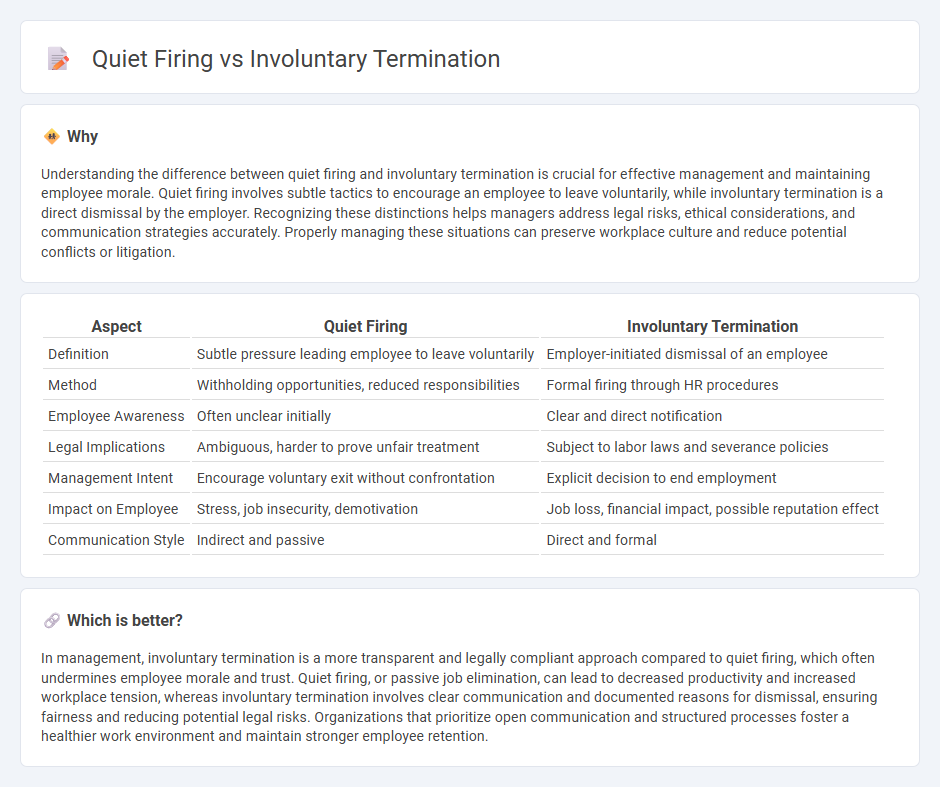
Quiet firing involves subtly signaling dissatisfaction to encourage an employee to resign without formal termination, preserving company reputation and reducing legal risks. Involuntary termination is a formal, documented dismissal due to performance issues, misconduct, or organizational changes, often accompanied by clear communication and legal compliance. Explore the nuances and strategic implications of both methods to optimize workforce management.
Why it is important
Understanding the difference between quiet firing and involuntary termination is crucial for effective management and maintaining employee morale. Quiet firing involves subtle tactics to encourage an employee to leave voluntarily, while involuntary termination is a direct dismissal by the employer. Recognizing these distinctions helps managers address legal risks, ethical considerations, and communication strategies accurately. Properly managing these situations can preserve workplace culture and reduce potential conflicts or litigation.
Comparison Table
| Aspect | Quiet Firing | Involuntary Termination |
|---|---|---|
| Definition | Subtle pressure leading employee to leave voluntarily | Employer-initiated dismissal of an employee |
| Method | Withholding opportunities, reduced responsibilities | Formal firing through HR procedures |
| Employee Awareness | Often unclear initially | Clear and direct notification |
| Legal Implications | Ambiguous, harder to prove unfair treatment | Subject to labor laws and severance policies |
| Management Intent | Encourage voluntary exit without confrontation | Explicit decision to end employment |
| Impact on Employee | Stress, job insecurity, demotivation | Job loss, financial impact, possible reputation effect |
| Communication Style | Indirect and passive | Direct and formal |
Which is better?
In management, involuntary termination is a more transparent and legally compliant approach compared to quiet firing, which often undermines employee morale and trust. Quiet firing, or passive job elimination, can lead to decreased productivity and increased workplace tension, whereas involuntary termination involves clear communication and documented reasons for dismissal, ensuring fairness and reducing potential legal risks. Organizations that prioritize open communication and structured processes foster a healthier work environment and maintain stronger employee retention.
Connection
Quiet firing and involuntary termination are interconnected through employer strategies aimed at encouraging employee departure without direct dismissal, often by reducing responsibilities, limiting growth opportunities, or creating a hostile work environment. Both practices reflect management decisions to manage workforce reductions, maintain productivity, and control costs while avoiding potential legal and reputational risks associated with formal termination processes. Understanding the dynamics of quiet firing reveals underlying organizational challenges in employee retention and highlights the necessity for transparent communication and ethical management practices.
Key Terms
Employee Dismissal
Involuntary termination involves explicit dismissal of an employee by the employer due to performance issues, misconduct, or organizational changes, often documented with formal notices. Quiet firing, also known as passive termination, occurs when employers subtly push employees to resign through tactics like exclusion, reduced responsibilities, and lack of growth opportunities, without direct acknowledgment of dismissal. Explore the nuances and implications of these employee dismissal strategies to better understand their impact on workplace dynamics.
Workplace Culture
Involuntary termination involves an explicit dismissal due to performance or conduct issues, reflecting a clear managerial decision impacting workplace culture transparency. Quiet firing, a subtler practice where employers reduce responsibilities or exclude employees to encourage voluntary resignation, undermines trust and can deteriorate the overall workplace morale. Explore deeper insights into how these practices shape organizational culture and employee engagement.
Performance Management
Involuntary termination involves formally ending an employee's contract due to poor performance or misconduct, often following documented performance management processes and warnings. Quiet firing, by contrast, occurs when an employer subtly pressures an employee to leave by reducing responsibilities or excluding them from opportunities, avoiding direct confrontation or formal documentation. Explore deeper insights into these performance management strategies and their impact on workplace dynamics.
Source and External Links
Involuntary termination: Overview, definition, and example - Cobrief - Involuntary termination occurs when an employer ends an employee's job against their will due to reasons such as layoffs, company restructuring, poor performance, misconduct, or policy violations, and it requires compliance with labor laws and fair treatment to avoid legal issues.
Involuntary Termination: What Does It Actually Mean? - Careerminds - This term refers to employment ending by employer decision for reasons beyond the employee's control, often including performance issues, misconduct, economic factors, or organizational changes, and usually includes support like severance and outplacement services.
Involuntary Termination: Meaning, Reasons, and Examples - AIHR - Often called being fired, involuntary termination happens when an organization ends employment due to financial cuts, reorganizations, poor performance, attendance, or misconduct, typically distinguishing it from voluntary resignation or retirement.
 dowidth.com
dowidth.com